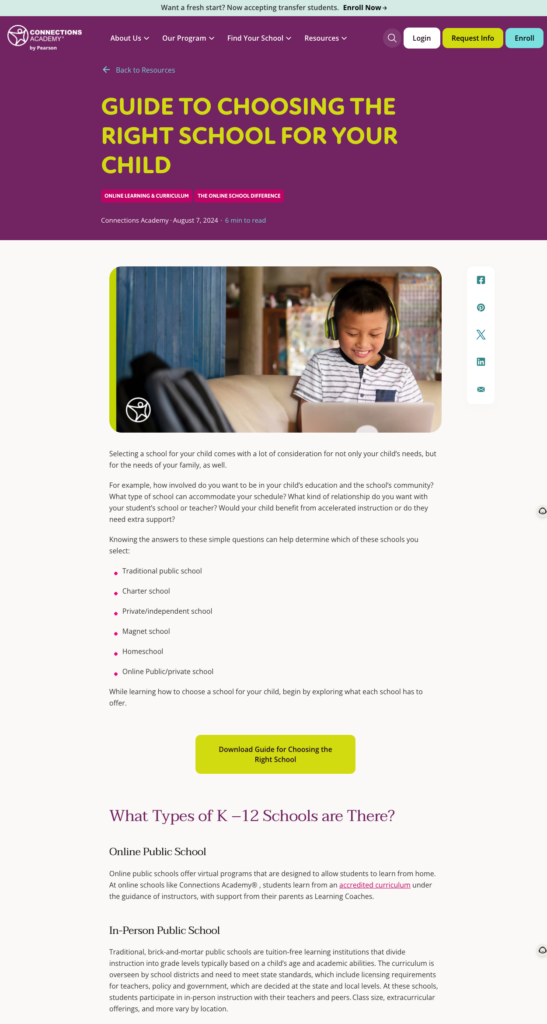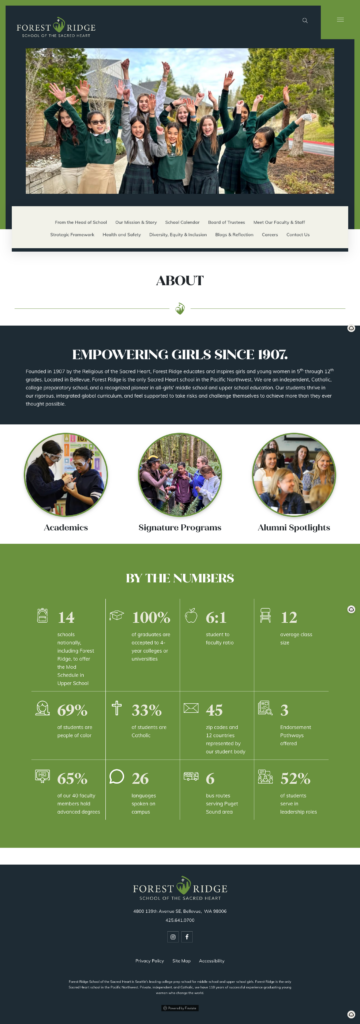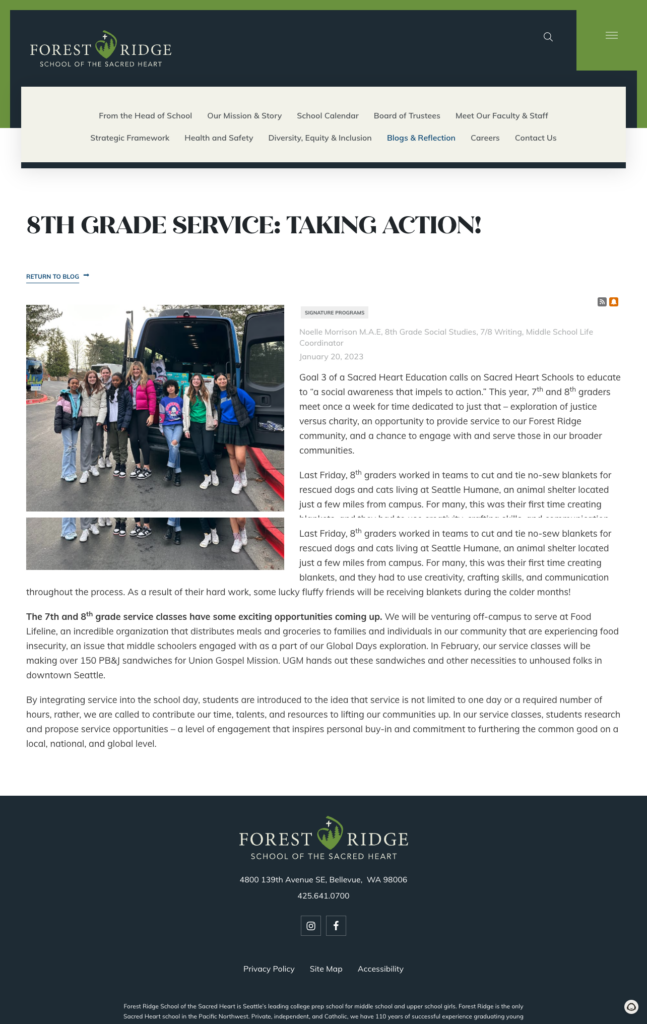Private schools face a competitive landscape where standing out from the crowd is key to attracting the right families. Did you know that over 60% of parents use online resources to research and compare schools before making enrollment decisions? This makes a strong online presence more vital than ever. This is where Search Engine Optimization (SEO) plays a crucial role. Effective SEO strategies can amplify your school’s visibility, draw in prospective families, and ultimately boost enrollment rates. By leveraging the right techniques, from local SEO to engaging content creation, private schools can position themselves as the top choice in a crowded digital arena. This blog will guide you through actionable steps to make your school shine online.
Key SEO Strategies Tailored for Private Schools
Understanding Target Audiences
The first step in building an effective SEO strategy is understanding who you’re trying to reach. For private schools, the target audience typically includes prospective parents, students, and even alumni. Each group has unique needs and questions when exploring private school options.
Potential parents, for example, may search for smaller class sizes, specialized programs, or strong college preparation. They might have questions like, “What makes this school different from public schools?” or “How does the school handle academic challenges and emotional well-being?” Students, on the other hand, might focus on extracurriculars, sports, or campus life, while alumni may look for ways to stay connected or support their alma mater.
Using keyword research tools like Google Keyword Planner or SEMrush can provide valuable insights into search patterns. These tools reveal the terms parents commonly search for, the frequency of these searches, and related topics. By addressing specific needs and pain points identified during keyword research, private schools can align their content with what families are genuinely looking for. This helps build trust and relevance with their audience.
Identify Relevant Keywords

Once you know your audience, the next step is pinpointing the right keywords. Focus on high-intent terms that prospective families are likely to search for. Examples include:
- “Private schools near me”
- “Top private schools in [City/Region]”
- “Best private schools for STEM/arts/athletics”
These keywords indicate that families are actively researching options and may be ready to take the next step in their school search.
Don’t stop there—long-tail keywords can be a goldmine, especially for private schools with niche programs. For example, if your school offers a specialized robotics curriculum, terms like “Best STEM schools for robotics in [Location]” can help you capture a highly specific audience. Long-tail keywords typically have less competition, making it easier for your school to rank higher in search results.
Another tip is to incorporate variations of your keywords into your content naturally. Overloading your site with exact matches (a practice known as keyword stuffing) can hurt your SEO more than it helps. Instead, aim for flow and readability while still weaving in key terms.
Competitor Analysis
Private schools exist in a competitive space, and understanding what similar institutions are doing is key to setting yourself apart. Competitor analysis involves studying the SEO tactics of other private schools and even local public schools.
Start by identifying which schools rank highly for your target keywords. Look at their websites—what types of content are they creating? How are they presenting their programs, and what gaps can you identify in their messaging? For instance, if competitors are underplaying the importance of extracurricular activities, your school could create detailed content showcasing robust offerings in sports, music, or clubs.
Also, analyze their calls-to-action (CTAs). Are they leading visitors to schedule tours, download admissions guides, or contact them directly? Understanding what’s working for others can inspire new ideas for your own strategy.
Don’t forget to evaluate their backlinks. Tools like Ahrefs or Moz can show you where competing schools are generating links from. Partnering with similar or related organizations can help you build your own link profile and boost your site’s authority.
Technical SEO

Even the best content won’t rank highly if your website isn’t technically sound. Search engines prioritize websites that offer a seamless user experience, so technical SEO is a must for private schools looking to improve searchability.
- Mobile-Friendly Design
More than half of web traffic now comes from mobile devices, so it’s crucial for your school’s website to work flawlessly on phones and tablets. Ensure the design adjusts to fit smaller screens and that navigation and calls-to-action remain accessible.
- Fast Loading Times
Page speed doesn’t just affect user experience—it’s also a ranking factor for search engines. Studies show that a delay of just one second in page load time can result in a 7% reduction in conversions and a 53% increase in bounce rates for mobile users. Compress large images, use a reliable hosting provider, and minimize unnecessary code to improve load times and keep users engaged.
- Proper URL Structure and Meta Tags
Clean, descriptive URLs and properly optimized meta tags (titles and descriptions) make your content easier for search engines to understand. For instance, a tuition page URL like “yourschool.com/tuition-costs” is much clearer than something generic like “yourschool.com/page123.”
By combining strong, audience-focused content with solid technical SEO practices, private schools can improve their rankings and make a better impression on prospective families.
Tips for Optimizing Website Content for Private Schools
Build Compelling Landing Pages

Landing pages are your school’s first chance to make a powerful impression. These pages should focus on the unique strengths of your institution and encourage visitors to explore further or take action. For instance, a page titled “Why Choose [School Name]?” could highlight what sets your school apart, be it smaller class sizes, advanced placement programs, or success stories of alumni. Similarly, an “Admissions Process” page can provide a step-by-step guide, reducing ambiguity and making it easier for parents to act.
Each landing page should have a clear goal, whether it’s encouraging families to schedule a tour, submit an inquiry, or download an admissions packet. Use persuasive headlines, call-to-action buttons, and concise, engaging content to guide users. Combine this with testimonials or accolades to build credibility, and always make sure the information is easy to scan and digest.
Use Engaging Visual Content
A picture is worth a thousand words—and videos, even more. Your website should feature high-quality images and videos that showcase the heart of your school. Photos of the campus, classrooms, extracurricular activities, and happy students help parents visualize the environment their children will be stepping into.
Videos, such as a virtual campus tour or student testimonials, can provide a deeper, more personal connection. Keep your visuals authentic—candid shots of students participating in classes, sports, or arts programs tend to resonate better than overly polished or staged photos.
Don’t forget to include alt tags for all images. These short descriptions not only make your site more accessible for visually impaired users but also help search engines understand your content. For example, a photo of a soccer game could include an alt tag like “Students enjoying a soccer match at [School Name]’s sports field.”
Optimize Blog Content

Blogs provide an excellent opportunity to answer common questions and address key concerns of prospective families. Effective blog content improves your SEO rankings while positioning your school as a thought leader in education.
Here are some blog ideas you could start with:
- “10 Benefits of Private School Education” – Highlight the advantages parents might not have considered, like character building, personalized learning, or unique extracurriculars.
- “How to Choose the Right Private School for Your Child” – Offer guidance on what factors families should prioritize, from academic offerings to location.
- Parent and Student Testimonials – Stories that showcase positive experiences at your school can help inspire trust and authenticity.
Ensure each blog includes internal links leading to key pages on your site, such as admissions, tuition, or specific programs. For example, a blog discussing STEM benefits could link directly to a landing page about the school’s advanced science offerings. This improves site navigation and encourages longer visits.
Improve “About Us” and Faculty Pages

The “About Us” page is often one of the most visited parts of any educational website. Use this space to tell your school’s story in a way that’s compelling and keyword-rich. Mention the school’s history, mission, and values while weaving in terms that reflect what families are likely searching for, such as “top-rated private school in [Location].”
Your faculty pages are another area to build trust and credibility. Include professional bios for your teachers, highlighting their qualifications, years of experience, and any special certifications. Incorporate stories or testimonials that reflect students’ academic achievements under their guidance.
Don’t underestimate the impact of student success stories on these pages. A section showcasing alumni accomplishments—such as college acceptances, scholarships, or career milestones—can leave a lasting impression and make families more inclined to pursue your school for their own children.
By applying these tips, your website can become a powerful tool that not only captures attention but also drives meaningful engagement and action from prospective families.
The Role of Local SEO for Private Schools
Claim and Optimize Google My Business
Google My Business (GMB) is a powerful tool that can significantly enhance your school’s local visibility. Start by claiming and fully optimizing your GMB profile. Include essential details such as your school’s name, address, phone number, website link, and operating hours. Upload a variety of high-quality pictures—of the campus, classrooms, sports facilities, and events. These visuals give prospective families a sneak peek into your institution and help make a lasting first impression.
Reviews Matter

Reviews can make or break a parent’s perception of your school. Studies show that 93% of consumers say online reviews influence their purchasing decisions, and schools are no exception. Encourage current families and alumni to leave honest reviews on your GMB profile. Positive feedback not only builds credibility but also improves your search rankings. To make this process seamless, provide direct links to your GMB profile in newsletters or post-event follow-up emails.
Focus on Local Keywords
Parents searching for private schools often specify their location, so using location-based keywords is vital. Optimize your website content with phrases like “Private schools in [City/Neighborhood]” or “[City] private education.” This ensures your school appears in search results when families are exploring their options nearby.
Go further by incorporating mentions of landmarks or community connections. For instance, if your school is near a popular park or major highway, referencing these can make it easier for parents to visualize your location. Likewise, highlighting your involvement in local events or partnerships strengthens your connection to the community, which resonates with families interested in schools that are well-integrated into the neighborhood.
Create Localized Content

Localized content is a key way to engage your community while improving your SEO efforts. Create blog posts or videos that focus on topics specific to your area, such as:
- Summaries of your school’s participation in events like local parades or charity drives.
- Case studies of how your school supports the unique needs of families in your community.
- Spotlights on partnerships with nearby businesses or organizations, such as sponsoring a local art show or sports league.
Content like this boosts your website’s relevance for local search queries and demonstrates how your school contributes to and cares for the community.
Build Backlinks with Local Organizations
Backlinks from reputable local websites signal to search engines that your school is a trusted authority in the area. Collaborate with local organizations—whether it’s cultural centers, businesses, or non-profits—in a way that benefits both parties.
For instance, you could host an event in partnership with a local business or sponsor a community charity initiative. These collaborations often lead to mentions or links back to your school on their respective websites or social media, increasing your SEO authority.
Another strategy is to create academic or extracurricular partnerships with local institutions, such as museums or sports clubs. Sharing these collaborations on their platforms (and yours) integrates quality backlinks into your campaigns while showcasing your community involvement.
By investing time and effort into local SEO tactics, private schools can attract more families who value accessibility and community engagement while improving overall search rankings.
Leveraging Social Media for SEO Benefits
Share Valuable Content

Social media is a powerful tool for highlighting the best aspects of your private school while driving traffic to your website. Regularly share updates about events, student achievements, and unique programs to keep followers informed and engaged. Posts about milestones, such as winning a championship or launching a new academic initiative, can boost interest and encourage sharing.
Additionally, link back to your website whenever possible. For instance, if your school has recently published a blog post like “How to Choose the Right Private School for Your Child,” share it on social media with a compelling caption. This not only increases the post’s reach but also directs readers to your website, enhancing SEO through increased visits and potential backlinks.
Encourage Engagement
The more your audience engages with your social media posts, the better your visibility and reach. Use storytelling to make an emotional connection with parents. For example, share a short narrative about a student’s experience with a particular program or their achievements after graduation. Accompany these posts with authentic images or videos to capture attention.
Promoting school-specific hashtags is another way to amplify your online presence. Hashtags like #[SchoolNameAchievements] or #[SchoolNameCommunityMatters] make it easier for users to find related content, helping you build a branded social media identity. Encourage parents, students, and alumni to use these hashtags when sharing their own posts about the school, further enhancing awareness and engagement.
Social Media Platforms to Focus On
Not all platforms are created equal when it comes to private school marketing. Focusing on the platforms most relevant to your audience will save resources and maximize impact.
- Facebook – This is one of the best platforms for reaching parents. Use it to share event updates, school news, and resources. Facebook Groups can also be a hub for connecting with current families and answering prospective parents’ questions.
- Instagram – With its visual nature, Instagram is ideal for showcasing campus life, sports events, performances, and day-to-day activities. Use stories, reels, and carousels to create visually appealing content.
- LinkedIn – This platform is perfect for professional networking and alumni engagement. Use it to share updates about faculty achievements, alumni successes, and partnerships with organizations. It’s also a good space to promote thought leadership by posting articles or research related to education.
By strategically tailoring content for each platform’s audience and strengths, you’ll not only engage your community but also drive more targeted traffic to your website.
Link Social Media Profiles to the Website
Don’t miss the opportunity to create seamless connections between your social media profiles and your website. Include the website link in your bio or profile sections on all platforms. For instance, a call-to-action like “Visit our website to learn more about admissions” can encourage users to click through.
Additionally, posts that direct audiences to specific pages, like admissions or extracurricular programs, can help drive meaningful traffic. This not only improves user engagement but also strengthens your overall SEO by signaling relevance and generating more site visits.
By leveraging social media effectively, private schools can not only foster a stronger community but also support their broader SEO goals, ensuring their online presence reaches as many prospective families as possible.
6 Actionable Steps to Start Improving SEO Today
For private schools looking to enhance their online visibility and attract more families, getting started with SEO can feel overwhelming. Breaking it into manageable steps will make the process more approachable and effective.
1. Perform a Basic Website Audit to Identify Technical Issues
The foundation of any successful SEO strategy is a well-functioning website. Start by completing a basic website audit to uncover technical issues that may hinder your site’s performance. Look for factors like:
- Broken links – These can frustrate users and harm your rankings.
- Page load speed – Slow-loading pages deter visitors and can negatively affect your site’s visibility.
- Mobile-friendliness – Ensure your website functions seamlessly on smartphones and tablets, as most users are likely to access your site on these devices.
An automated site audit tool or a checklist of common issues can help you spot and fix problems quickly.
2. Research Keywords and Start Integrating Them into Existing Content
Once your website is technically sound, it’s time to focus on the content. Use keyword research tools to discover what terms prospective families are searching for. Focus on both high-intent and location-based keywords, such as:
- “Best private schools in [City]”
- “Private school with strong arts program”
- “STEM-focused schools near me”
Integrate these keywords naturally into your existing copy, such as landing pages, program descriptions, and admissions information. Avoid keyword stuffing—prioritize producing clear, engaging content that resonates with your audience.
3. Claim the School’s Online Profiles, Like Google My Business, and Optimize Them
If you haven’t already, claim your school’s Google My Business (GMB) profile or similar listings, such as Bing Places. This ensures that prospective families can easily find accurate and detailed information about your school in local search results.
Take the time to optimize the profile by adding:
- The school’s name, address, and phone number.
- High-quality images of the campus and events.
- A detailed description of your offerings and links to your website.
- Up-to-date hours of operation and contact information.
Encouraging families to visit your Google profile can also boost the likelihood of positive reviews.
4. Plan and Publish Your First Blog Post Using Local or Branded Keywords
If your school doesn’t already have a blog, now is the perfect time to start. Identify a topic parents care about, and incorporate location-based or branded keywords into the post. Some great starter topics include:
- “Why Private Schools in [City] Offer the Best Education Values.”
- “5 Steps to a Smooth Private School Admissions Process.”
- “How [School Name] Prepares Students for the Future.”
Publishing this content helps attract search engine users while building credibility and trust with prospective parents. Include clear calls-to-action in the blog, such as links to your admissions page or a request for tour inquiries.
5. Encourage Families and Alumni to Leave Positive Reviews Online
Reviews are a key factor in both rankings and reputation. Reach out to current families, alumni, and partners, encouraging them to share their experiences online. Positive endorsements on platforms like Google Reviews, Facebook, or school rating sites can influence decision-making for prospective parents.
To make it easier for families to participate:
- Share direct links to your review pages in email newsletters.
- Use a “Review Us” button in your website footer or homepage.
- Include review reminders in follow-up emails after school events or meetings.
6. Monitor Performance Using Tools Like Google Analytics to Track Progress
Improving SEO is an ongoing process, and tracking your efforts is critical to achieving results. Set up free tools like Google Analytics or Google Search Console to measure your progress. Pay attention to metrics like:
- Website traffic – Look for increases in visits over time.
- Bounce rate – Ensure users are engaged and navigating through your site.
- Keyword rankings – Track whether your site ranks higher for targeted keywords.
Regularly reviewing these stats will help you identify what’s working and what needs tweaking. For instance, if certain blogs are driving significant traffic, consider creating more content on similar topics.
By following these six steps, private schools can begin to build a stronger SEO presence, making it easier for them to connect with families who are looking for their next educational home. Take it step by step, and you’ll see meaningful improvements in your school’s online reach.
Final Thoughts
Mastering SEO is essential for private schools aiming to strengthen their online visibility and connect with prospective families. From refining website content and leveraging local SEO to creating engaging social media strategies, these efforts ensure your school stands out in an increasingly digital-driven world. Remember, SEO isn’t a one-time task but an ongoing process that requires consistent updates and adjustments to stay ahead of changes in trends and search algorithms. By taking proactive steps and prioritizing your online presence, your school can build stronger relationships with its community, attract the right families, and remain competitive in the education sector. Start small, stay consistent, and watch your efforts yield long-term benefits.

